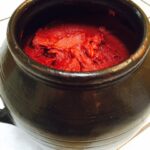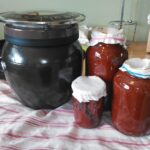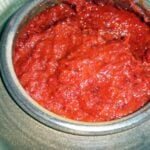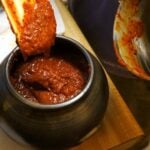I’m thrilled to introduce you to my homemade Korean hot pepper paste (gochujang) recipe today. Yes, eventually! Over the years so many of my readers and viewers have requested the recipe for gochujang, but I thought I couldn’t make it until I visited Jamie Frater’s house in New Zealand during my Gapshida trip last year. To make good, well-fermented gochujang, you need good quality ingredients, an earthenware pot to make it in, and a sunny place for it to ferment. Making gochujang is easy, but taking care of it requires lots of patience and hard work.
Gochujang needs direct sunlight, so after you make it you need to open the earthenware pot on sunny mornings to let the sunlight hit it, and be sure to cover it in the evening. You have to stir it sometimes and turn it over from the bottom to the top so that it’ll be mixed and fermented evenly. As time goes on, your gochujang will turn shiny and turn a richer red. If you go outside to meet your friend but it suddenly rains and you forgot to close the lid, your gochujang will be spoiled.
Besides this, gochujang should not be made in the heat of summer or it will ferment too fast and explode. One of my Korean friends studying in the USA brought a container filled with his mother’s homemade gochujang on the airplane. He took it in his carry on. A long time ago, it was possible for people to bring gooey stuff like hot pepper paste, soybean paste, and even kimchi on an airplane. We have so many funny stories about this.
So my friend’s gochujang exploded on the airplane. Store bought gochujang is processed to stop fermenting, but homemade gochujang never stops, just like kimchi. The gas from the fermentation process kept pushing the lid of the container until it blew up. My friend’s mother must have packed it tightly with plastic bags and tape.
I’m living in an apartment in Manhattan without a patio, so it seemed impossible for me to make something that needs lots of direct sunlight to ferment well. Well-fermented gochujang is really delicious, and a totally different flavor from gochujang bought in a store. For a delicious meal you can simply mix it with warm rice, chopped kimchi, and toasted sesame oil.
So on my Gapshida trip, Korean food fan Jamie Frater invited me to his house to cook together. We filmed my popcorn chicken gizzard recipe video and the next day we filmed this gochujang video. The cameraman, Ryan Sweeney, is also a big fan of Korean food.
Jamie was waiting for me with all the ingredients for gochujang as well as Korean earthenware pots: onggi. He brought these from a trip to Korea that he won in a Korean food blog contest 2011 on the basis of his Korean food writing.
This Korean gochujang was made in New Zealand and taken care of by Jamie for months. It’s really international!
Makes about 16 quarts
Ingredients
- 2 pounds of barley malt powder (yeotgirem)
- water
- 10 cups of sweet rice flour
- 8 cups of rice syrup
- 4 cups (1½ pounds) of fermented soybean powder (mejugaru)
- 16 cups (1.6 kg) of hot pepper powder
- 4 cups of kosher salt
Directions
- Mix 8 liters (32 cups) of water and 2 pounds of barley malt powder (yeotgireum) in a large basin
- Strain the mixture and put it in a large heavy bottomed pot.
- Heat it up on the stove for about 20 minutes until it’s warm. Dip your finger in to test it: it should be warm, not hot.
- Remove it from the heat and add sweet rice flour. Mix well with a wooden spoon.
- Let it sit for 2 hours. The liquid on the surface will look a lot clearer, and it will taste a little sweet.

- Bring to a boil for about 2 hours over medium high heat, until it reduces by ¼-⅓ (about 28-30 cups).
*tip: Stir occasionally with a wooden spoon so it doesn’t burn to the bottom of the pot.

- Add the rice syrup and mix well.
- Remove from the heat and wait until it completely cools down.
- Add mejugaru and mix well. Then add hot pepper powder and mix well. Lastly add salt, and stir until there are no lumps in the paste.


- Transfer it to an earthenware pot or glass jar and cover with mesh or cheesecloth before closing the lid.

- It will take about 2-3 months to properly ferment. During that time it’s best to open the lid and let it sit in the sunlight during the daytime, and close it at night.
Jamie updated me recently about his gochujang with a few photos and emails. I missed the gochujang a lot! Jamie loves the texture and flavor of it, which made me very happy. Thank you very much Jamie for your effort taking care of the gochujang and updating us! Many of my readers will be encouraged to make their own homemade gochujang because of him.
He emailed:
“The gochujang came out great! It is a little thicker than commercial gochujang but I don’t think that is a problem at all. The flavor is deeper and slightly less salty than store bought pepper paste which is good I think. The hot New Zealand summer sun took great care of our precious paste! I can’t wait to see our video! I have attached 5 of the best photos I took of the gochujang.”
Well fermented gochujang! The top layer looks dark red and a little dry! I can almost smell the aroma from this photo!
Beautiful gochujang is showing off its bright red color! Thank you my gochujang! You grew up well, thanks to Jamie! : )
On the left is homemade gochujang, and on the right is store-bought gochujang. A big difference!
Maangchi's Amazon picks for this recipe
It's always best to buy Korean items at your local Korean grocery store, but I know that's not always possible so I chose these products on Amazon that are good quality. See more about how these items were chosen.















































